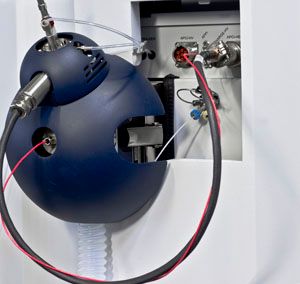New Bruker ionBooster dramatically improves LOQ and LOD for various compounds on UHR-TOF systems and amaZon ion traps with MSn capabilities
Bruker announces the release of its high-sensitivity ionBooster, a new ion source to meet the increasing demands for sensitivity enhancements in environmental analysis, food testing and forensics.

Bruker released its high-sensitivity ionBooster, a new ion source to meet the increasing demands for sensitivity enhancements in environmental analysis, food testing and forensics. Sensitivity gains of 5x to 100x are achievable for many compounds extending the quantitative capability of modern accurate-mass MS systems to the sensitivity range of high-end triple-quadrupole instruments.
The ion source enhances sensitivity and lowers detection limits by delivering more efficient ionization across a wide range of applications. Inside the ionBooster, an electrospray is maintained at a controlled vaporizing temperature to enable enhanced desolvation of the analyte ions, even at high eluent flow rates in UHPLC separations with sharp chromatographic peaks. The exact response with the ionBooster depends upon the type of compound and its specific chemical characteristics and thermal properties.
A gain in sensitivity, delivered by ionBooster provides significant enhancement in response for chloramphenicol (CAP) compared with standard ESI. Such a development is of great importance, as there is zero-tolerance for Chloramphenicol, a broad-spectrum antibiotic drug, in any food in the EU. An LOQ more than 100-fold better than the minimum required performance level (MRPL) can be achieved with ionBooster. In combination with maXis™ impact, Bruker’s latest UHR-TOF system, accurate-mass data is obtained across the full mass range, enabling qualitative analysis of unknowns, analysis of multiple drugs or target compounds, and retrospective screening of data for any target formula.
Fundamentals of Benchtop GC–MS Data Analysis and Terminology
April 5th 2025In this installment, we will review the fundamental terminology and data analysis principles in benchtop GC–MS. We will compare the three modes of analysis—full scan, extracted ion chromatograms, and selected ion monitoring—and see how each is used for quantitative and quantitative analysis.
Characterizing Plant Polysaccharides Using Size-Exclusion Chromatography
April 4th 2025With green chemistry becoming more standardized, Leena Pitkänen of Aalto University analyzed how useful size-exclusion chromatography (SEC) and asymmetric flow field-flow fractionation (AF4) could be in characterizing plant polysaccharides.
This information is supplementary to the article “Accelerating Monoclonal Antibody Quality Control: The Role of LC–MS in Upstream Bioprocessing”, which was published in the May 2025 issue of Current Trends in Mass Spectrometry.




